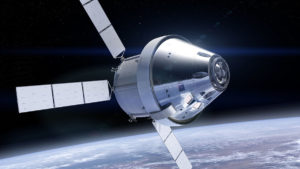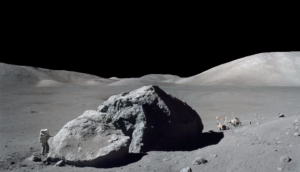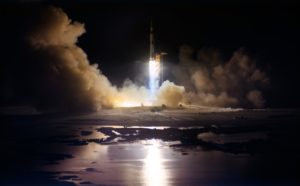
The new Orion spacecraft — Cadillac or Edsel?
Throwing a wrench into NASA’s engine of progress may not have been the intent of Vice President Pence’s first meeting of the National Space Council with his announcement that a human return to the lunar surface is the new direction for America’s human spaceflight program. But a wrench it was and will remain until pieces of the formerly touted “Journey to Mars” – the heavy lift SLS launch vehicle, the Orion spacecraft, and a relatively recent addition, the Deep Space Gateway (DSG, a small human-tended space station in a distant orbit around the Moon) – are reimagined and torqued into the new strategic direction.
Much venom has been hurled at the SLS launch vehicle, largely on the grounds of its alleged cost and its origins as a “government rocket” (i.e., “pork”). But heavy lift launch capability is extremely useful for the emplacement of a substantial cislunar infrastructure. Heavy lift permits the launch of large and/or multiple vehicles and facilities all at one time, and that makes the coordination of their arrival and assembly at a selected trans-LEO destination easier. The core SLS vehicle delivers 70-80 metric tones to LEO, more than enough to put about 10 tones on the lunar surface, or 15-20 tones into low lunar orbit. In addition, a large rocket also offers a large shroud diameter; volume can actually be more critical than throw mass for large architecture pieces like big landers and habitat elements. Technically, the SLS is a good fit for any future lunar return architecture.
The main argument against the SLS is its cost, but current estimates of $1-2 billion per launch are based primarily on the low projected flight rate planned by the previous program of record, which called for very few missions. A faster pace of a lunar surface return could bring these costs down, although they would still be in the range of multi-hundreds of millions of dollars per flight. If the long-promised and long-awaited commercial heavy lift vehicle eventually emerges, this estimate of cost – and the choice of a heavy lift launch vehicle – should be re-evaluated (but not until then).
The Deep Space Gateway (DSG) is an idea that comes from a variety of architectural studies that looked at the use of a staging node placed beyond LEO – well outside of Earth’s gravity well, for a human Mars mission. Initially focused on the Earth-Moon Lagrange Points, subsequent studies converged on something called a Near Rectilinear Halo Orbit, a complex path around the Moon that is relatively stable (requiring little orbital maintenance propulsion). The orbit selected for initial study is quite far from the Moon, up to 70,000 km distant. While this distance may make a good staging orbit for a departing Mars mission, it cannot easily support missions to low lunar orbit or to the lunar surface – the new strategic direction (delta-v to the surface from this orbit is near lunar escape velocity, ~2400 m/s).
In our published architectures (Spudis-Lavoie – Using the resources of the Moon to create a permanent, cislunar space faring system (2011) and Lavoie-Spudis – The Purpose of Human Spaceflight and a Lunar Architecture to Explore the Potential of Resource Utilization (2016), a propellant depot/transfer node is placed in low lunar orbit to keep the lunar lander transport a single-stage-to-orbit (SSTO) vehicle, making the lander completely reusable. Moving the node point to the Earth-Moon L-1 point costs roughly an extra 800 m/s in delta-v. Our lander design is already challenged with the requirement of re-usability (mostly propulsion system concerns: multi-start use lifetime, with little to no maintenance) and by having an engine-out capability to provide reasonable abort scenarios. Other design considerations include extreme temperature variations (thermal cycles) and parts fatigue, which results in higher subsystem mass than a single-use lander. All of these factors lead us to place the depot/node at the lowest reasonable point in orbit around the Moon, ~100 km circular. Orbital maintenance is on the order of 500 m/s/yr, which is achievable for the depot. After initial operations, the depot/node can change its orbit to a more advantageous one should future lander designs prove more capable.
Properly reconfigured, the DSG could serve as a low lunar orbit habitat-depot-node. This would require re-thinking its mission (fuel depot in addition to habitat) and its thermal design, because low lunar orbit can be quite warm on the daytime side of the Moon. The “lumpiness” of the uneven lunar gravity field (mascons) makes low orbits unstable and considerable propulsion is necessary to maintain it. However, we now have lunar gravity maps of extraordinary quality that reveal “frozen orbits” – ones where virtually no orbital maintenance is required (the currently operating LRO spacecraft is in such a frozen orbit). Use of these orbits would need to be traded against accessibility and lander energy cost, but in any event, a propellant depot would possess more than adequate propulsion for orbital maintenance. Finally, and most importantly, a station in low lunar orbit is well placed to support operations in space and on the lunar surface.
If both the SLS and the DSG could be adapted to the requirements of lunar surface return, what about Orion? Consider this: Orion was originally conceived as a component of the Constellation spaceflight system; it was designed to transport people to and from the Moon in a manner similar to the Apollo spacecraft. In short, this was a mission launched “all up” from Earth, with pieces discarded after use along the way. In the case of Constellation, two vehicles, Ares I and V, would launch the Orion and the Altair and transfer stage, respectively. The two vehicles would dock in low Earth orbit and depart for the Moon. Burning into lunar orbit, the crew would transfer to the Altair lunar lander and descend and land on the Moon for a period of a couple of weeks. After exploration of the landing site, the crew would ascend to the orbiting Orion and transfer into it for their journey home. The Orion spacecraft would discard its service module and re-enter the atmosphere at near-escape velocity, splashing down in the ocean for recovery. At each step in the above mission sequence, parts are discarded and not reused, requiring high levels of funding and leaving little, if any, hardware in space as legacy infrastructure.
When the Constellation program was cancelled in 2010, Orion was the only piece preserved, largely because at the time, it was the only spacecraft capable of sending American astronauts into space. However, without its Altair lander, Orion was no longer a lunar spacecraft system. It instead became a vehicle whose only purpose is to send crew into trans-LEO space and allow them to return to Earth with aero-thermal entry. It can support a crew of four, for periods of a couple of weeks, but cannot last much longer. It is for this reason that the ill-conceived Asteroid Retrieval Mission (ARM) concept was born – designed to give Orion someplace to go and something to do. Despite the fact that the ARM was nearly worthless scientifically and operationally, it was a mission configured to the capabilities of the Orion spacecraft. To support this scaled back mission profile, the current edition of the Service Module for the Orion (built by the Europeans) is smaller than the previous edition under Constellation. Unfortunately, that also means that the Orion can get into (but cannot then get out of) low lunar orbit, taking from Orion what little value it had for a possible lunar mission.
Where does that leave things as NASA contemplates lunar return? We currently have three pieces of space hardware, each configured to support a vaguely defined series of missions to deep cislunar space. The SLS can be adapted to transport all the pieces we need to establish and operate an outpost on the Moon. The Deep Space Gateway can be modified to operate in low lunar orbit, making it a possible staging node for trips to and from the Moon’s surface. But that still leaves us with Orion. True enough, crew members leaving the Moon will need a way to return to Earth, but if a permanent outpost is established there, we need to develop a reusable system that transports crew and cargo to and from low Earth orbit on a recurring basis (a reusable cislunar transfer stage). Such a vehicle would fire a rocket to accelerate out of LEO into a translunar trajectory. Approaching the Moon, it could burn into and out of low lunar orbit, delivering crew and supplies to be transferred into the lunar lander vehicle. On the way home, rather than direct entry and landing on Earth, it would aerobrake (i.e., use Earth’s atmosphere to slow the vehicle from escape velocity to orbital velocity) into Earth orbit and rendezvous with a transfer node in LEO. Here the crew would transfer to a commercial vehicle for return to Earth. All of these systems have been envisioned, at least conceptually, by a variety of published architectures over the last decade.
But can Orion be repurposed? In contrast to most informed opinion, I believe that of the three major human spaceflight pieces described here, Orion is the one that is the least useful and most likely to vanish. This should not be too surprising, considering that it is an orphaned, smaller piece of a larger system designed to return people to the Moon. Yet work continues on Orion, heedless of any possible change in mission – and has done so throughout the last 8 years as its mission gradually morphed from Moon-Mars spacecraft, to an asteroid spacecraft, to a “Space Station in Deep Space” spacecraft. This bureaucratic resilience suggests that setting Orion aside is a nonstarter – contractors and Congressional advocates may insist on its continuation, in a manner similar to the SLS “lobby,” which assured continuity of that development program.
Ideally, one would design a return to the Moon using a clean sheet, focusing on early robotic presence and a series of newly imagined, modular, reusable space-based human assets. However, we do not live in that world. So the question is how to “MacGyver” what we have to get what we need. Listed in order of decreasing usefulness, SLS, DSG and Orion can all be used in a lunar return. The SLS provides us a way to get large, heavy payloads to the Moon. The DSG, while not currently configured to support lunar surface activities, could be modified to do so without too much re-design. The Orion could be used for early human flights to the DSG – establishing a human presence near the Moon, while robots would do much of the early resource prospecting and processing work on the surface. After human return to the lunar surface, Orion could be docked at the DSG and serve as a “lifeboat” vehicle in the event that emergency circumstances require the outpost crew return quickly to Earth.
From Super-Apollo to crew assured-return vehicle – a diminished ending to a once-noble vehicle development? Possibly. It depends on your point of view. As it currently exists, Orion is not a particularly useful spacecraft. But if we use it to help establish a permanent human presence on the Moon, it will have served a noble purpose indeed.






